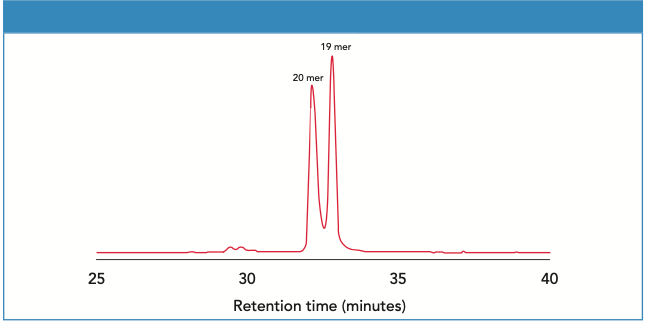Tosoh Bioscience - Analysis of Oligonucleotides by SEC
The oligonucleotide therapeutics field has seen remarkable progress over the last few years and oligonucleotides are increasingly recognized as potential therapeutic agents for a variety of diseases. Here we describe the ability of ultra-high pressure size exclusion chromatography (SEC) to distinguish N and N-1 oligonucleotide species.
Oligonucleotide-based therapeutics have made rapid progress in the clinic for treatment of a variety of disease indications. In recent years several oligonucleotide drugs for gene silencing, such as short interfering RNA (siRNA) and antisense oligonucleotides (ASOs) have been approved and microRNA (miRNA) and aptamers are being developed as therapeutic platforms. The promising CRISPR-Cas system also requires a specific RNA moiety—guiding RNA—to recruit and direct the Cas nuclease activity.
Therapeutic oligonucleotides are produced through synthetic solid- phase chemical synthesis. Despite improvements in oligonucleotide synthesis and the most ardent post synthesis clean-up, there will be some heterogeneity with regard to chain distribution. Monitoring this distribution is a fundamental aspect of process and quality control. This assessment is typically done by capillary gel electrophoresis or anion- exchange chromatography. Here, we present the ability of size-exclusion chromatography to discriminate oligonucleotides differing by one base in length. A TSKgel® UP-SW2000 column was used in combination with UHPLC and UHPLC-MALS systems.
Analysis of Oligonucleotides by SEC
TSKgel UP-SW2000 is a newly developed silica-based 2 μm, 12.5 nm pore size SEC column designed for the separation of small proteins, peptides, and oligonucleotides. The column can be used in both HPLC and UHPLC systems and is ideally suited for method transfer from conventional HPLC size-exclusion columns to UHPLC technology. Two 30 cm TSKgel UP-SW2000 columns in series were used to analyze a mixture of two oligonucleotides differing by only one base.
Materials and Method
Column: TSKgel UP-SW2000, 2 μm, 4.6 mm ID × 30 cm × 2
Mobile phase: 50 mmol/L phosphate buffer, pH 6.7, 300 mmol/L NaCl, 0.03% NaN3
Flow rate: 0.2 mL/min
Detection: UV @ 260 nm
Sample: 19-mer (5’-AATTCATCGGTTCAGAGAC-3’) & 20-mer (5’-GAATTCATCGGTTCAGAGAC-3’)
Figure 1 demonstrates that the TSKgel UP-SW2000 column can be used to separate a 20-mer and its N-1 19-mer.
Figure 1: Separation of N and N-1 oligonucleotides.

SEC-MALS Analysis of Oligonucleotides
Crude and purified oligonucleotide samples were analyzed by SEC-MALS using a newly developed multi-angle light scattering detector, the LenS3TM from Tosoh Bioscience.
Materials and Method
Column: TSKgel UP-SW2000, 2 μm, 4.6 mm ID × 30 cm
Instrument: Thermo Fisher Ultimate® 3000 UHPLC system with LenS3 MALS
0.5 mol/L NaCl, 0.1 mol/L EDTA, pH 7.5
Mobile Phase: 0.1 mol/L Na2SO4, 0.03% NaN3 in 0.1 mol/L phosphate buffer
Flow Rate: 0.3 mL/min
Detection: UV @ 260 nm
Injection Volume: 10 μL
Sample: 20 bases custom oligonucleotide with MW = 6141 Da (purified sample 0.3 mg/mL; crude sample 1 mg/mL)
Figure 2 shows the comparison of chromatograms of the crude and purified oligonucleotide samples.
Figure 2: Overlay of unpurified and purified 20-mer UV chromatograms.

Figure 3 shows the molecular weight distribution of the unpurified 20-mer. The molecular weight trace clearly indicates the presence of higher and lower molecular weight impurities.
Figure 3: Molecular weight distribution (green) of the unpurified 20-mer.

Figure 4: Peak analysis of the unpurified 20-mer.

The peak analysis from Figure 4, as detailed in Table I, allows a molecular weight profiling of the product and the impurities. The MALS analysis of the purified sample (Figure 5) proves the high purity of the 20-mer oligonucleotide. The good reproducibility of retention time and calculated molecular weight of the purified 20-mer is shown in Table II (triplicate injection).

Figure 5: Molecular weight distribution of the purified 20-mer.


Conclusions
TSKgel UP-SW2000 is a size-exclusion column designed for UHPLC analysis of biomolecules of a molecular weight of 1 to 150 kDa. The separation range is ideally suited to analyze small proteins or peptides and their aggregates. This application note demonstrates that this column can also be used to analyze oligonucleotides by UHPLC. Multi-angle light scattering detection delivers additional information on the molecular weight of the oligonucleotide and any impurities present in the sample.
TSKgel and Tosoh Bioscience are registered trademarks of Tosoh Corporation.
LenS is a trademark of Tosoh Bioscience LLC.
UltiMate is a registered trademark of the Dionex Corporation.

Tosoh Bioscience LLC
3604 Horizon Drive, Suite 100, King of Prussia, PA 19406
tel: (484) 805-1219, fax: (610) 272-3028
Website: www.tosohbioscience.com

SEC-MALS of Antibody Therapeutics—A Robust Method for In-Depth Sample Characterization
June 1st 2022Monoclonal antibodies (mAbs) are effective therapeutics for cancers, auto-immune diseases, viral infections, and other diseases. Recent developments in antibody therapeutics aim to add more specific binding regions (bi- and multi-specificity) to increase their effectiveness and/or to downsize the molecule to the specific binding regions (for example, scFv or Fab fragment) to achieve better penetration of the tissue. As the molecule gets more complex, the possible high and low molecular weight (H/LMW) impurities become more complex, too. In order to accurately analyze the various species, more advanced detection than ultraviolet (UV) is required to characterize a mAb sample.









